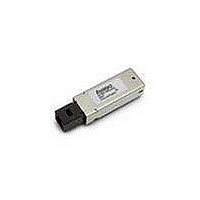AFBR-5905EZ Avago Technologies US Inc., AFBR-5905EZ Datasheet - Page 5

AFBR-5905EZ
Manufacturer Part Number
AFBR-5905EZ
Description
TXRX ATM/SONET OC-3 2X5
Manufacturer
Avago Technologies US Inc.
Datasheet
1.AFBR-5905Z.pdf
(13 pages)
Specifications of AFBR-5905EZ
Wavelength
1308nm
Data Rate
*
Applications
General Purpose
Voltage - Supply
3.135 V ~ 3.465 V
Connector Type
MTRJ
Mounting Type
Through Hole
Function
MMC OC-3 PB-Free MTRFJ
Product
Transceiver
Maximum Rise Time
3 ns, 2.2 ns
Maximum Fall Time
3 ns, 2.2 ns
Pulse Width Distortion
0.21 ns, 0.15 ns
Maximum Output Current
50 mA
Operating Supply Voltage
3.135 V to 3.465 V
Maximum Operating Temperature
+ 70 C
Minimum Operating Temperature
0 C
For Use With
Multimode Glass
Lead Free Status / RoHS Status
Lead free / RoHS Compliant
Application Information
The Applications Engineering group is available to assist
you with the technical understanding and design trade-
offs associated with these transceivers. You can contact
them through your Avago sales representative. The fol-
lowing information is provided to answer some of the
most common questions about the use of these parts.
Transceiver Optical Power Budget versus Link Length
Optical Power Budget (OPB) is the available optical power
for a fiber optic link to accommodate fiber cable losses plus
losses due to in-line connectors, splices, optical switches,
and to provide margin for link aging and unplanned losses
due to cable plant reconfiguration or repair.
Figure 4 illustrates the predicted OPB associated with the
transceiver specified in this data sheet at the Beginning
of Life (BOL). These curves represent the attenuation and
chromatic plus modal dispersion losses associated with
the 62.5/125 µm and 50/ 125 µm fiber cables only. The area
under the curves represents the remaining OPB at any link
length, which is available for overcoming nonfiber cable
related losses. Avago LED technology has produced 1300
nm LED devices with lower aging characteristics than nor-
mally associated with these technologies in the industry.
The industry convention is 1.5 dB aging for 1300 nm LEDs.
The 1300 nm Avago LEDs are specified to experience less
than 1 dB of aging over normal commercial equipment
mission life periods. Contact your Avago sales representa-
tive for additional details.
5
125 µm fiber cables only. The
area under the curves
represents the remaining OPB
at any link length, which is
available for overcoming non-
fiber cable related losses.
Agilent LED technology has
produced 1300 nm LED
devices with lower aging
characteristics than normally
associated with these
technologies in the industry.
The industry convention is 1.5
dB aging for 1300 nm LEDs.
The
1300 nm Agilent LEDs are
specified to experience less
than 1 dB of aging over normal
commercial equipment mission
life periods. Contact your
Agilent sales representative for
additional details.
Figure 4 was generated for the
1300 nm transceivers with a
Agilent fiber optic link model
containing the current industry
conventions for fiber cable
specifications and the draft
ANSI T1E1.2. These optical
parameters are reflected in the
guaranteed performance of the
transceiver specifications in
this data sheet. This same
model has been used
Figure 4 was generated for the 1300 nm transceivers with
a Avago fiber optic link model containing the current in-
dustry conventions for fiber cable specifications and the
draft ANSI T1E1.2. These optical parameters are reflected
in the guaranteed performance of the transceiver specifi-
cations in this data sheet. This same model has been used
extensively in the ANSI and IEEE committees, including
the ANSI T1E1.2 committee, to establish the optical per-
formance requirements for various fiber optic interface
standards. The cable parameters used come from the ISO/
IEC JTC1/SC 25/WG3 Generic Cabling for Customer Prem-
ises per DIS 11801 document and the EIA/TIA-568-A Com-
mercial Building Telecommunications Cabling Standard
per SP-2840.
Figure 4. Typical Optical Power Budget at BOL
versus Fiber Optic Cable Length.
extensively in the ANSI and
IEEE committees, including the
ANSI T1E1.2 committee, to
establish the optical
performance requirements for
various fiber optic interface
standards. The cable
parameters used come from
the ISO/IEC JTC1/SC 25/WG3
Generic Cabling for Customer
Premises per DIS 11801 docu-
ment and the EIA/TIA-568-A
Commercial Building
Telecommunications Cabling
Standard per SP-2840.
12
10
8
6
4
2
0
0.
3
0.5
FIBER OPTIC CABLE LENGTH (km)
HFBR-5905, 62.5/125 µm
1.0
HFBR-5905
50/125 µm
1.5
2.0
2.5
























